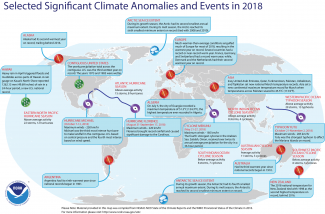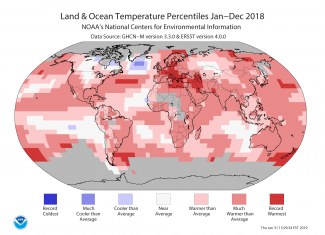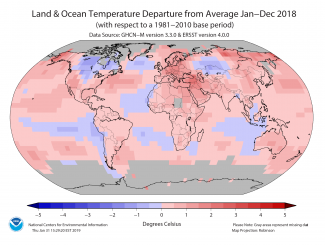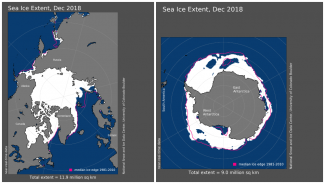For the globe, 2018 becomes fourth warmest year on record

December’s combined global land and ocean average surface temperature departure from average was the second warmest December in the 139-year record. With 11 of 12 monthly global land and ocean temperature departures from average ranking among the five warmest for their respective months, 2018 became the fourth warmest year in NOAA's 139-year record.
This summary from NOAA National Centers for Environmental Information is part of the suite of climate services NOAA provides to government, business, academia and the public to support informed decision-making.
In a separate analysis of global temperature data, released today, NASA scientists also determined 2018 to be the fourth warmest year on record. Analyses from the United Kingdom Met Office and the World Meteorological Organization ranked 2018 among the top four warmest years on record.
Global climate highlights: 2018
-
Global land and ocean surface temperature: For 2018, the average temperature across global land and ocean surfaces was 1.42°F (0.79°C) above the 20th century average. This was the fourth highest among all years in the 1880–2018 record, behind 2016 (highest), 2015 (second highest), and 2017 (third highest).
-
2018 marks the 42nd consecutive year (since 1977) with global land and ocean temperatures at least nominally above the 20th century average.
-
Nine of the 10 warmest years have occurred since 2005, with the last five years (2014–2018) ranking as the five warmest years on record. The year 1998 is the only year from the 20th century among the 10 warmest years on record, currently tying with 2009 as the ninth warmest year on record.
-
During the 21st century, the global land and ocean temperature departure from average has reached new record highs five times (2005, 2010, 2014, 2015 and 2016), with three of those records being set in consecutive years. During the first century of the NOAA record (1880 to 1980), a new record high temperature was set on average every 13 years; however, for the more recent period of 1981–2018, the frequency of a new record has increased to once every three years on average.
-
The annual global land and ocean temperature has increased at an average rate of 0.13°F (0.07°C) per decade since 1880; however, since 1981 the average rate of increase is more than twice that rate (0.31°F / 0.17°C).
-
For the 21-year span considered to represent pre-industrial conditions (1880-1900), the 2018 global land and ocean temperature was 1.75°F (0.97°C) above the average.
-
-
Global land surface temperature: For 2018, the globally averaged land surface temperature was 2.02°F (1.12°C) above the 20th century average. This was the fourth highest among all years in the 1880–2018 record, behind 2016 (highest), 2015 (second highest), and 2017 (third highest).
-
Record high annual temperatures over land surfaces were measured across much of Europe, New Zealand, and parts of the Middle East and Russia. No land areas were record cold for the year.
-
Five continents had an annual average temperature that ranked among their eight highest on record. Of note, Europe’s 2018 temperature was the highest on record at 3.20°F (1.78°C) above average. Overall, Europe's annual temperature has increased at an average rate of 0.22°F (0.12°C) per decade since 1910; however, it has almost quadrupled to 0.77°F (0.43°C) since 1981.
-
-
Global ocean surface temperature: The 2018 globally averaged sea surface temperature was 1.19°F (0.66°C) above the 20th century average. This was the fourth highest among all years in the 1880–2018 record, again behind 2016 (highest) and 2015 (second highest) and 2017 (third highest).
-
Record high sea surface temperatures were observed across parts of the southern Pacific Ocean, specifically the ocean surrounding much of New Zealand, parts of the North and South Atlantic Ocean, and the northwestern Pacific Ocean. No ocean areas were record cold for the year.
-
The annually averaged ocean temperatures of both the Gulf of Mexico and the Hawaiian region were third highest in their respective record.
-
The Caribbean region had its lowest annual ocean temperatures since 2012, while the Atlantic Main Development Region had its lowest annual temperature since 2001.
-
Snow and Sea Ice Information: 2018
-
Northern Hemisphere snow cover: According to NOAA data analyzed by the Rutgers Global Snow Lab, the average annual Northern Hemisphere snow cover extent for 2018 was 9.90 million square miles. This was about 300,000 square miles above the 1981–2010 average and the 12th largest in the 1968–2018 record.
-
Arctic sea ice extent: Recent trends in the decline of Arctic sea ice extent continued in 2018. When averaging monthly data from the National Snow and Ice Data Center, the average annual sea ice extent in the Arctic was approximately 4.00 million square miles. This edged out the 2017 value of 4.01 million square miles as the second smallest annual average in the 1979–2018 record, about 90,000 square miles larger than the record small extent set in 2016. Record-low Arctic sea ice was observed the first two months of 2018.
-
Antarctic sea ice extent: The annual Antarctic sea ice extent was 4.20 million square miles. This was the second smallest annually averaged value on record, about 77,000 square miles larger than the previous record set in 2017.
Global climate highlights: December 2018
-
Global land and ocean surface temperature: For December, the average temperature across global land and ocean surfaces was 1.55°F (0.86°C) above the 20th century average. This value was the second highest departure from average for December in the 1880–2018 record. Only December 2015 (+2.03°F / +1.13°C) was warmer.
-
Global land surface temperature: For December, the globally averaged land surface temperature was 2.11°F (1.17°C) above the 20th century average and tied with 1939 as the eighth warmest December in the 1880–2018 record.
-
Global ocean surface temperature: For December, the globally averaged sea surface temperature was 1.35°F (0.75°C) above the 20th century average. This was the second highest temperature departure from average for December in the 1880–2018 record, trailing behind 2015 by 0.18°F (0.10°C).
-
Northern Hemisphere snow cover: According to data from NOAA analyzed by the Rutgers Global Snow Lab, the Northern Hemisphere snow cover extent during December was 17.20 million square miles, which is 220,000 square miles above the 1981–2010 average. This was the 15th largest December value in the 53-year record.
-
Arctic sea ice extent: The average Arctic sea ice extent for December was 4.58 million square miles, according to analysis by the National Snow and Ice Data Center based on data from NOAA and NASA. This value was 378,000 square miles (7.6 percent) smaller than the 1981–2010 average and the fourth smallest December extent since records began in 1979.
-
Antarctic sea ice extent: Antarctic sea ice during December was 3.49 million square miles, according to analysis by the National Snow and Ice Data Center. This value is 530,000 square miles (13.3 percent) smaller than the 1981–2010 average and the second smallest December extent on record.
A more complete summary of climate conditions and events, see our 2018 Annual Global Climate Report.







